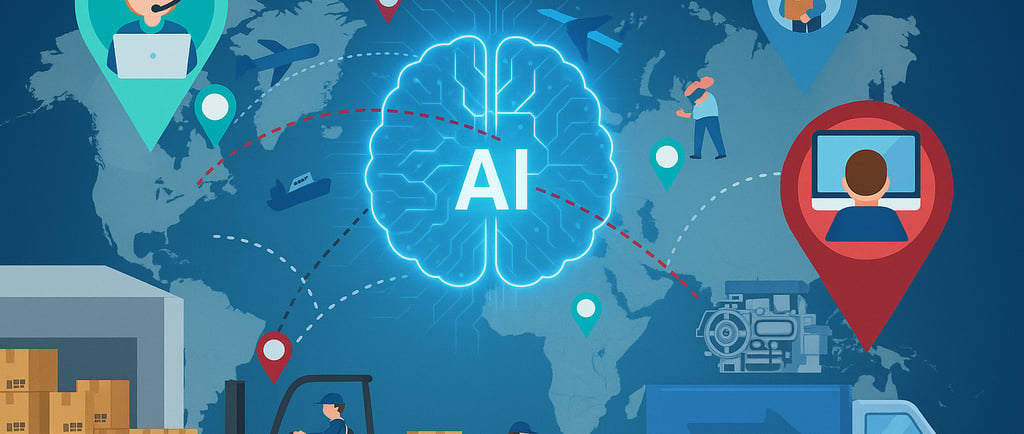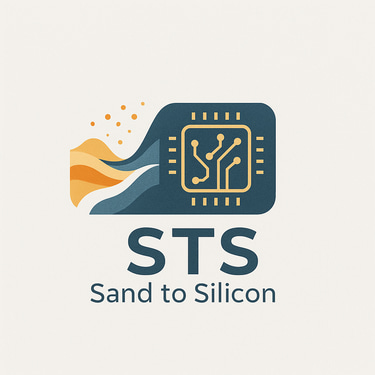Beyond Automation: How AI is Reshaping the Future of Supply Chains
In this article, I'll explore six compelling use cases that showcase how GenAI and Agentic AI are delivering measurable, transformative impact; particularly in electronics, semiconductors, and industrial supply chains.
Sanjay K. Sah
6/25/20255 min read


Across industries, supply chains are under pressure like never before. From global disruption and geopolitical uncertainty to sustainability mandates and volatile demand, organizations face mounting complexity in every link of the value chain. However, a powerful shift is underway. Generative AI (GenAI) and Agentic AI are not only boosting efficiency, they’re fundamentally reshaping what it means to have a resilient and agile supply chain.
In this article, I'll explore six compelling use cases that showcase how GenAI and Agentic AI are delivering measurable, transformative impact; particularly in electronics, semiconductors, and industrial supply chains.
📈 1. Enhanced Demand Forecasting & Inventory Optimization
Accurate forecasting is crucial for any business, but traditional methods often fall short in today’s unpredictable markets. Generative AI (GenAI) offers a significant leap forward by combining structured data (like sales records and inventory levels) with unstructured information (such as social media trends, news articles, and economic indicators). This allows for a much richer and more nuanced understanding of market dynamics. When paired with Agentic AI, which can autonomously adjust inventory levels and safety stocks in real-time, businesses can dramatically reduce instances of running out of stock (stockouts) and improve how quickly products move through their system (inventory turnover).
Real-world impact: Consider how a major retailer like Walmart leverages this. By using GenAI to analyze both their internal sales data and external factors like weather patterns and social media chatter, Walmart can more accurately predict demand spikes. This allows their AI-powered system to dynamically adjust inventory allocations and replenishment schedules across their vast network of distribution centers. The result? Fewer empty shelves, less wasted inventory, and a smoother, more efficient operation that minimizes disruptions for customers.
🔍 2. Intelligent Component Search & Alternate Solutions
In manufacturing, unexpected shortages or the discontinuation of critical components can bring production to a halt, leading to significant financial losses. Generative AI addresses this by rapidly analyzing complex technical documents, such as bills of materials (BOMs) and component datasheets, to identify suitable alternative parts. Agentic AI then takes this a step further by evaluating the availability of these substitutes, ensuring they meet regulatory standards (like RoHS and REACH for environmental compliance), and assessing the reliability of potential suppliers. This automation of procurement workflows helps maintain a continuous supply of necessary parts.
Real-world impact: Imagine a global manufacturer of specialized equipment facing a crisis because a key machine component is no longer produced. Instead of lengthy manual searches and engineering redesigns, a GenAI-powered system can quickly extract technical specifications from existing design files (like CAD files) and instantly recommend compatible replacement parts. The Agentic AI then validates these substitutes, checks real-time inventory across multiple locations, and can even automate the process of requesting quotes from suppliers. This dramatically reduces the time it takes to replace parts, minimizes production delays, and saves countless engineering hours, ensuring operations remain smooth and efficient.
📄 3. Contract Writing & Management
Managing the vast array of agreements with suppliers, partners, and customers—including warranties, service level agreements (SLAs), and non-disclosure agreements (NDAs)—is a complex and time-consuming task. Generative AI streamlines this process by automatically drafting contracts based on historical data and established company standards, significantly reducing manual effort and potential errors. Agentic AI then provides continuous oversight, monitoring these contracts for compliance, proactively flagging any deviations or issues, and ensuring that critical renewals are never missed. This frees up legal and procurement teams to focus on more strategic activities.
Real-world impact: A major semiconductor equipment manufacturer like ASML, for instance, has integrated AI-powered legal assistants into their contract management systems. This technology can automatically ingest and analyze contracts, identify clauses that deviate from company policy, and summarize key obligations and deadlines. The Agentic AI components then trigger alerts for upcoming renewals and compliance checks. This not only reduces the time legal teams spend on contract review by a significant margin (e.g., 15–20%) but also improves the consistency and standardization of contracts across the organization, ultimately enhancing overall compliance and reducing legal risks.
🚨 4. Autonomous Supplier Risk Monitoring
Traditional methods for assessing supplier risk, often relying on infrequent audits and static data, are no longer sufficient to respond to today’s rapidly evolving global threats. Agentic AI provides a continuous, real-time monitoring capability by aggregating vast amounts of data from diverse sources, including global news feeds, environmental, social, and governance (ESG) data, regulatory filings, and even shipping records. Generative AI then synthesizes this complex information, proactively identifies potential risks, and suggests actionable strategies to mitigate them before they escalate. This proactive approach is critical for maintaining supply chain stability.
Real-world impact: Consider a multinational electronics manufacturer that deployed an Agentic AI platform to enhance its supplier risk management. This system constantly scans for emerging risks, such as environmental violations or labor disputes, across its entire supplier network. Using GenAI, the platform contextualizes these alerts, providing immediate insights into the severity and potential impact of the risk. It can then automatically update supplier profiles and trigger mitigation workflows, such as identifying alternative sourcing options or initiating compliance checks. This allows the company to identify and address issues with lower-tier suppliers early, enabling proactive shifts to backup suppliers and preventing costly disruptions to their production and delivery schedules.
🚚 5. Optimized Operations & Logistics
Logistics operations are constantly battling external factors like volatile fuel prices, unpredictable weather, port congestion, and geopolitical shifts, all of which can severely impact delivery times and costs. Generative AI tackles these challenges by optimizing routing and shipment consolidation in real-time, adapting to dynamic conditions. Agentic AI then takes these optimized plans and autonomously executes them, updating shipment details, communicating with drivers, and proactively managing any emerging risks. This ensures that goods move efficiently and reliably through the supply chain.
Real-world impact: A large logistics provider, for example, significantly improved its delivery efficiency by implementing a GenAI-powered routing system. This system analyzes real-time data on traffic, weather, vehicle capacity, and even fuel prices to determine the most efficient routes. The Agentic AI then automatically adjusts these routes as conditions change, communicates these updates to drivers, and instantly updates delivery times within the logistics system. This integrated approach has led to substantial reductions in fuel costs and delivery delays, resulting in improved operational efficiency and higher customer satisfaction. It demonstrates how AI can bring agility and responsiveness to even the most complex logistical challenges.
🧭 6. Strategic Scenario Simulation & Resilience Planning
Supply chain disruptions often strike without warning, and relying solely on reactive measures is rarely enough to prevent significant damage. Generative AI empowers organizations to proactively prepare for such events through advanced scenario simulation, often utilizing digital twins; virtual replicas of physical supply chain operations. These digital twins allow businesses to model and test various disruption scenarios in a safe, virtual environment. Agentic AI then plays a crucial role by evaluating multiple contingency strategies simultaneously, ranking them based on their viability and effectiveness, and even autonomously initiating actions across the supply network when a real disruption occurs. This capability transforms supply chain resilience from a reactive to a proactive endeavor.
Real-world impact: The Port of Corpus Christi, one of the largest seaports in the U.S., provides a compelling example. They implemented a digital twin platform that uses AI to create a virtual replica of their entire port operations. By integrating GenAI for complex scenario simulations and Agentic AI for evaluating and executing contingency strategies, the port can now model and rehearse a wide range of potential disruptions; from ship congestion and chemical spills to severe weather events; before they happen. This proactive approach has significantly enhanced the port’s ability to respond quickly and effectively to real-world emergencies, ensuring operational continuity and improving overall resilience in the face of unforeseen challenges.
💡 Final Thought
AI in supply chain management isn't simply about efficiency; it's about building smarter, more resilient, and agile organizations. Whether forecasting demand, securing critical components, managing contracts, or navigating disruption, GenAI and Agentic AI empower companies to respond swiftly, intelligently, and proactively.
I'd love to hear your perspectives and experiences. How is your organization leveraging AI in the supply chain?
📚 Further Reading & References
